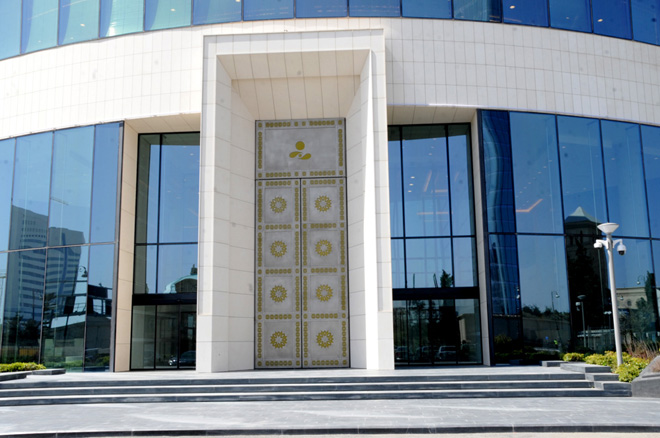Baku, Azerbaijan, June 28
By Azad Hasanli – Trend:
The State Oil Fund of the Azerbaijan Republic (SOFAZ) prefers to invest into the most matured companies, rather than start-ups, Shahmar Movsumov, SOFAZ’s executive director, said in an interview with Caspian Energy journal.
“Start-ups, an initial stage of financing of the venture capital, along with high yield in case of success, are associated with a relatively high degree of risk as such investments turn out successful in exceptional cases which makes it attractive for the riskiest market players (hedge funds, mutual funds),” Movsumov said.
“SOFAZ, in its turn, just like the majority of institutional investors follows a relatively conservative strategy in the field of private equities and therefore invests into the most matured companies,” Movsumov added.
Movsumov said that the main objective of SOFAZ's investment policy has always been to achieve the highest possible long-term profitability from asset management.
“Given the Azerbaijani society’s readiness to take financial risks, such types of assets as shares (including private investments), property and gold have been gradually included into the investment portfolio of the Fund since 2012,” Movsumov stressed.
“Since then, there has been a tendency towards increase of the share of high-yielding assets in our investment portfolio,” Movsumov added. “As a result, the rate of property and shares has been increased from 5 percent to 10 percent and from 10 percent to 15 percent respectively. We think that such tendency can continue but decision making will depend on many factors including the developments in the global economy.”
Movsumov stressed that SOFAZ has been traditionally following a more conservative investment policy.
“As is known, the main factor, impacting the long-term profitability of asset management, is the ratio of the share of high (for example, shares) and low-risk (such as bonds with high credit ratings) instruments in the investment portfolio,” Movsumov said. “In its turn it depends on the level of the risk that an investor is ready to take.”
“Norges Bank Investment Management’s (NBIM) investment strategy, aimed at profits increase, implies a sufficiently high rate of medium-term riskness/volatility of the investment portfolio,” Movsumov said. “According to this strategy, share investment account for 60 percent of NBIM’s portfolio, the share of less risky fixed income instruments makes 35-40 percent of the total portfolio while property investments can total up to 5 percent.”
“As far as SOFAZ is concerned, in addition to providing a long-term profitability it also fulfills the functions of the stabilization fund,” Movsumov said. “We have been traditionally following a more conservative investment policy compared to other world sovereign funds, which is why investments made by us into shares and similar instruments are lower. But as I have already mentioned, we will continue increasing the share of these assets in the common portfolio.”
“According to the major areas of application of SOFAZ investment policy for the year of 2016, intended distribution of the portfolio looks in the following manner: the portfolio of financial instruments with a fixed income and instruments of the short-term money market must account for 70 percent of investments; portfolio of shares must total up to 15 percent; property portfolio must total up to 10 percent; gold portfolio must total up to 5 percent,” Movsumov said.
“As of the end of the first quarter of 2016, 80.6 percent, 11 percent , 4.9 percent and 3.5 percent of SOFAZ’s investment portfolio accounted for financial instruments with a fixed income and instruments of short-term money markets, accounted for shares, for property and gold respectively,” Movsumov said.
Movsumov added that property investments are attractive for SOFAZ for many reasons.
“As you know, there have record-low indicators of bond yield in recent years and in these conditions the number of investors paying attention to alternative types of investments is growing,” Movsumov said. “Property investments are also popular among these options. Apart from this, these investments are interesting from the standpoint of diversification of the investment portfolio as well as partial hedging of investment risks.”
“Until recently, we have made direct investments into property in cities which have matured markets and stable rental yield,” Movsumov said. “But in the meantime, we have already started expanding indirect investments in Asia and Europe, which implies contributions to the investment funds aimed at raising profitability of our property portfolio.”
“At present, owing to increase of prices and stable rental yield, we gain sufficiently high profits from investments we made,” Movsumov added. “Thus, total cumulative return of property portfolio reached 24 percent since we started making investments in 2013.”
SOFAZ was established in 1999 with assets of $271 million.
As of April 1, 2016, SOFAZ's assets increased by 2 percent and amounted to $34.25 billion compared to early 2016 ($33.57 billion).
Based on SOFAZ's regulations, its funds may be used for the construction and reconstruction of strategically important infrastructure facilities, as well as solving important national problems.
The main goals of the State Oil Fund include: accumulation of resources and the placement of the fund's assets abroad in order to minimize the negative affect on the economy, the prevention of "Dutch disease" to some extent, promotion of resource accumulation for future generations and support of current social and economic processes in Azerbaijan.
The assets of the investment fund were placed as follows: 60.46 percent in European countries, 20 percent in North America, 3.62 percent in Australia, 11.80 percent in the Asia-Pacific Ocean region, 0.63 percent in the Middle East, 0.27 percent in South America, 3.21 percent in international financial organizations, Africa - 0.01 percent.






